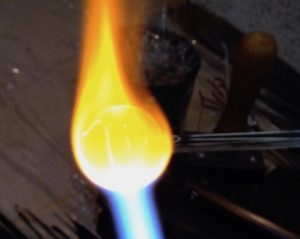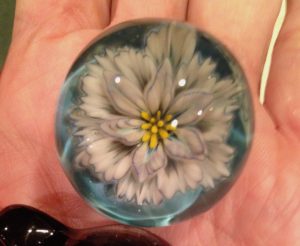Ehlers-Danlos Syndrome Took Something Away, but Gave Me More in Return
Written by |

There was a time when lampworking was my thing. In fact, my life revolved around it. What began as a hobby grew into a business. When I wasn’t behind a flame melting glass, I was on the phone or on internet message boards furthering my knowledge and sharing it with other glassworkers.
I enjoyed everything about glasswork: learning all the ins and outs, making pretty things, and sharing my joy and knowledge with others who wanted to learn. Focusing on the task in front of me allowed my stress to melt away.
I would get lost in the process of making small marbles and intricately patterned beads. My work involved holding glass and tools out in front of me for long periods of time, rotating the glass in and out of a flame to maintain the proper heat distribution. Intense focus was necessary, due to the hazards of working with fire and molten glass.
Carpal tunnel syndrome is a common ailment among lampworkers, and I used wrist supports in an effort to prevent it. Unfortunately, nerve impingement of some sort happened. The neck and shoulder pain that crept in while I worked would not register with me in my hyperfocused state until it was too late. Stopping immediately is not an option with hot glass.
Making intricate things became increasingly more painful, so I adjusted to simpler things — until it became too dangerous. My arms and hands would go numb while I worked, and I would drop tools, and sometimes the glass I was working. Losing the feeling and control of my hands was not something I could soldier through; it was a safety issue that meant I could no longer work glass in the flame.
A loss of abilities brought about a shift in perspective. Pursuing creativity called for adaptation.
I grieved the loss of my ability. I was angry and sad. Then I examined what exactly I would miss the most: learning, creating, sharing, focusing, and de-stressing. All of those things could be experienced through other pursuits!
I dove into new hobbies — paint pouring, alcohol inks, and airbrushing, to name a few — which required me to learn new information and develop new skills. Meeting these challenges gave me a sense of accomplishment. If I messed up along the way, I went easier on myself. After all, everyone new at these things messes up, not just people with Ehlers-Danlos syndrome (EDS).
The “mess” provided opportunities for exercising creativity, and learning in the process. Sometimes, I even lucked out with a neat outcome. EDS made adaptation a challenge, but that did not diminish the process or the results, and successes felt so much sweeter.
I’m finding that to be just as true with my life as it is with my creative pursuits.
***
Note: Ehlers-Danlos News is strictly a news and information website about the disease. It does not provide medical advice, diagnosis, or treatment. This content is not intended to be a substitute for professional medical advice, diagnosis, or treatment. Always seek the advice of your physician or other qualified health provider with any questions you may have regarding a medical condition. Never disregard professional medical advice or delay in seeking it because of something you have read on this website. The opinions expressed in this column are not those of Ehlers-Danlos News or its parent company, Bionews Services, and are intended to spark discussion about issues pertaining to Ehlers-Danlos.







Leave a comment
Fill in the required fields to post. Your email address will not be published.